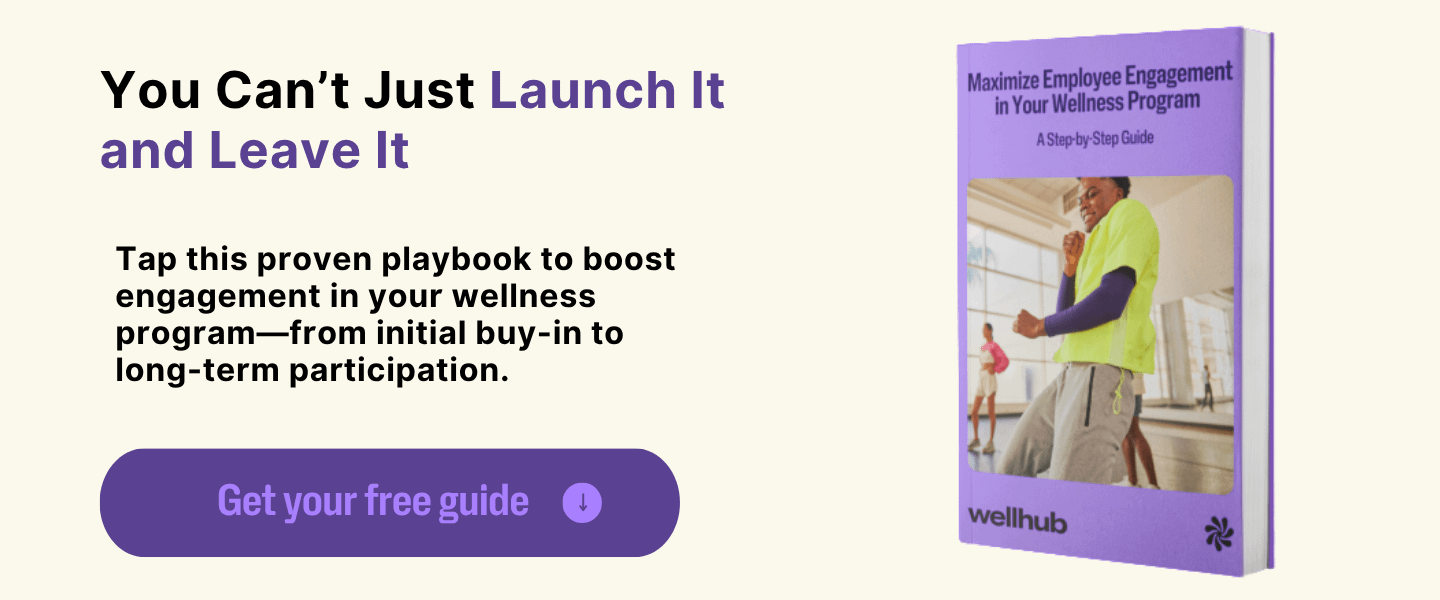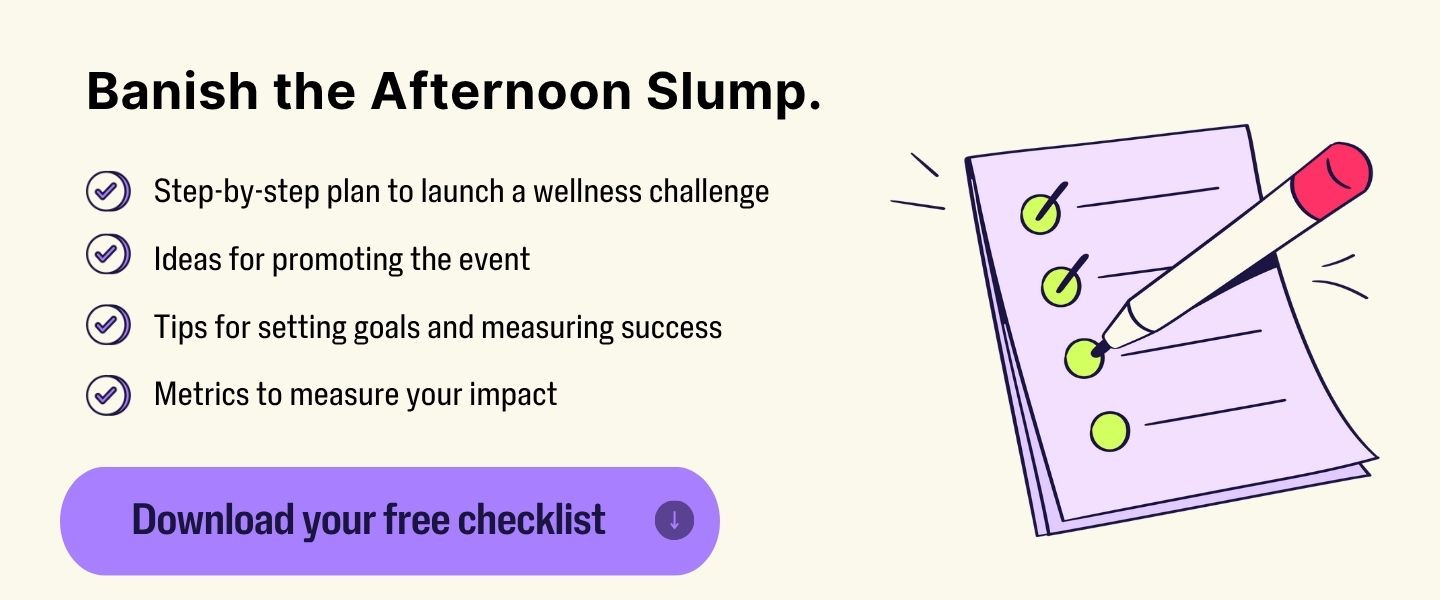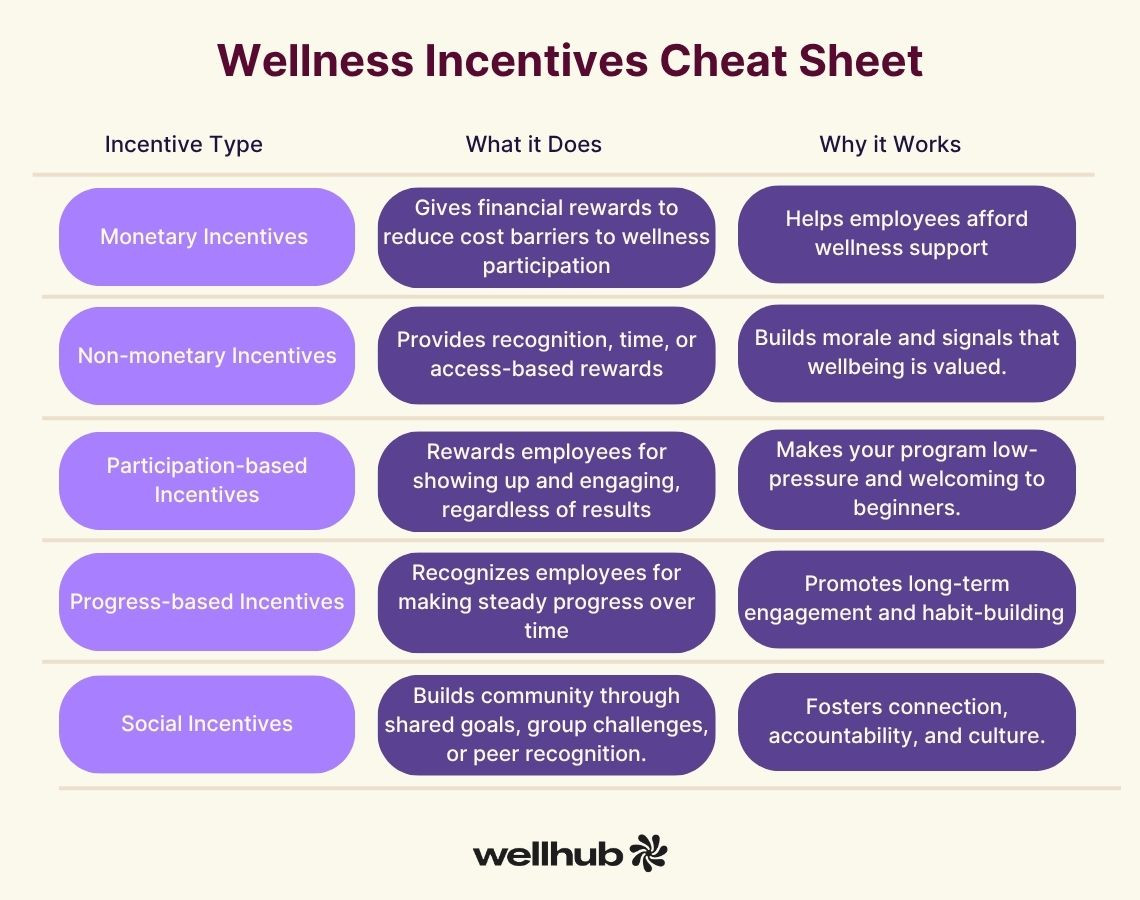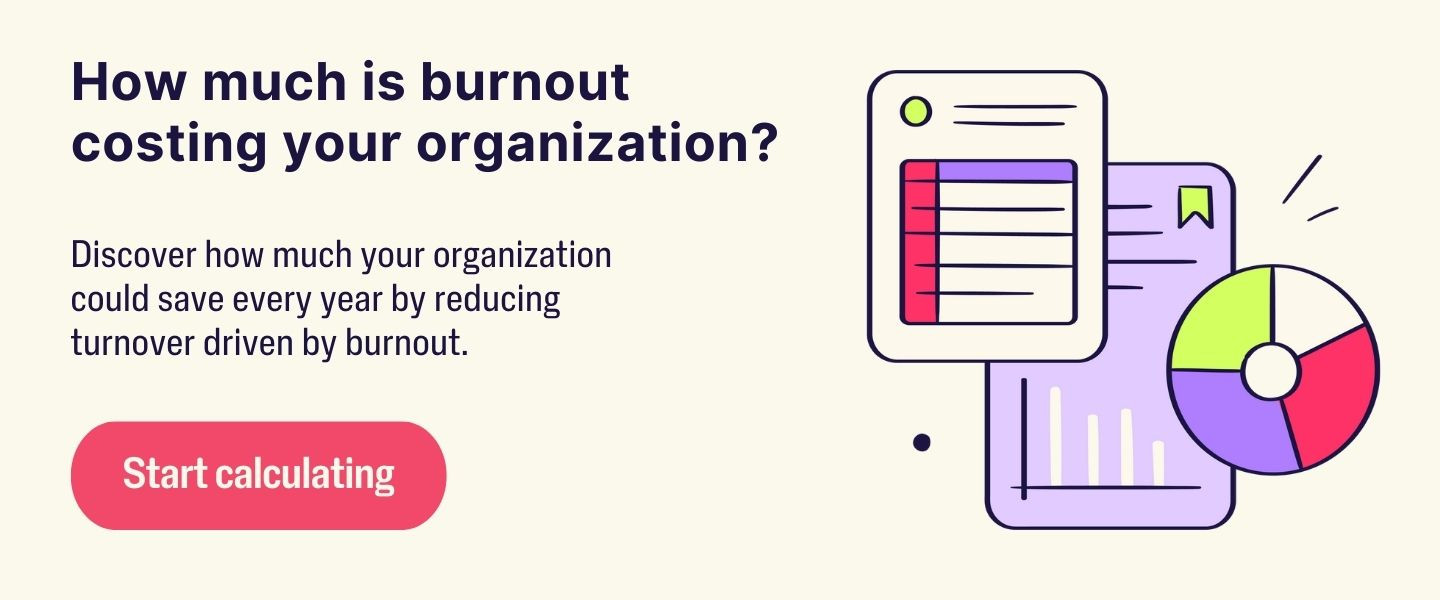The Ultimate Guide to Effective Wellness Incentives
Last Updated Jul 3, 2025

Employee wellbeing is on every HR agenda — but engagement? That’s the hard part.
You roll out programs. You share resources. But if employees don’t participate, none of it sticks. And when wellbeing efforts fall flat, burnout rises, healthcare costs climb, and culture takes a hit.
That’s where wellness incentives come in. The right rewards — from PTO and gift cards to public praise and peer challenges — turn good intentions into lasting habits.
Uncover the benefits of wellness incentives to drive real program engagement.
What You'll Learn
- Wellness Incentives Drive Real Engagement: Incentives — from gift cards and PTO to team challenges and peer recognition — transform employee participation in wellbeing programs from passive to active, helping reduce burnout and improve culture.
- A Variety of Incentives Reaches a Broader Workforce: Effective programs mix monetary, non-monetary, behavioral, and social incentives to meet diverse employee needs, values, and preferences — making wellness accessible, inclusive, and personalized.
- Behavior-Based Rewards Build Long-Term Habits: Participation- and progress-based incentives focus on effort and consistency rather than outcomes, helping employees develop and sustain healthy habits regardless of where they start.
- Social Incentives Foster Belonging and Accountability: Peer-driven programs like team challenges, buddy systems, and group rewards build community and create a culture of wellness through shared experiences and mutual encouragement.
- Automation and Personalization Make Programs Scalable: Integrating wellness platforms with HR tools streamlines reward delivery, simplifies tracking, and ensures timely, personalized recognition — critical for driving ongoing engagement and performance.

What are Wellness Incentives?
Wellness incentives are rewards employers offer to encourage employees to participate in healthy behaviors or wellness programs. These incentives can be monetary, like cash bonuses or insurance discounts, or non-monetary, like time off or public recognition. They’re designed to motivate employees to take proactive steps toward improving their physical, mental, and emotional wellbeing.
Wellness incentives are more than just perks — they’re strategic tools. When done right, they increase engagement, reduce healthcare costs, and support a culture of care. In fact, 95% of HR leaders who track ROI say their wellness programs are paying off.
Here’s how they typically work:
- Action is encouraged: For example, attend a meditation workshop, walk 10,000 steps a day, or complete a health risk assessment.
- Incentive is delivered: Employees might earn gift cards, HSA contributions, or extra PTO.
- Behavior is reinforced: Repeated rewards build healthy habits over time.
Wellness incentives benefit the entire organization. Employees who feel supported in their wellbeing are more productive, less likely to burn out, and far more likely to stay with your company.
Types of Wellness Incentives (with Examples)
Wellness incentives can supercharge participation in your wellness program — but only if they’re well-matched to what your team values. Incentives generally fall into four categories: monetary, non-monetary, behavioral, and social. Mixing and matching options from each category can help you support a more diverse range of employee needs and preferences.
Monetary Incentives
Monetary wellness incentives are all about reducing the financial barrier to engaging in wellness. They give employees real dollars or savings in exchange for healthier habits — which is a big deal when 68% of employees say their financial situation prevents them from investing in their wellbeing.
These incentives include:
- Gym membership reimbursements
- HSA contributions for completing wellness assessments
- Health insurance premium discounts for meeting specific health goals
- Gift cards or bonuses for participating in wellness challenges or quitting smoking
💡 Pro tip: Make these rewards as seamless as possible to claim — automation is your friend here. Use your HRIS or wellness platform to track participation and trigger rewards automatically. For example, integrate your step challenge app with your payroll provider to auto-issue gift cards or HSA contributions when milestones are hit. This keeps the experience smooth for employees — and manageable for you.
Non-monetary Incentives
Not all rewards have to hit your budget. Non-monetary incentives tap into recognition, time, and experience — three things employees deeply value.
Examples include:
- Extra paid time off for participating in a mental wellness challenge or scheduling preventative care
- Public recognition (like a feature in the company newsletter or a shoutout in an all-hands)
- Access to special events or workshops, like cooking classes or meditation retreats
- Priority parking or workspace perks for challenge winners
These incentives are powerful because they align with employee values and offer a sense of belonging — which is crucial when 98% of people say their belonging at work is important to my overall wellbeing.
💡 Pro tip: Use internal tools to make recognition feel immediate and personalized. Automate shoutouts through Slack or Microsoft Teams using wellness challenge bots, and schedule PTO or event invites through your HR platform. Timely kudos keeps momentum high!
Behavioral Incentives
Behavioral incentives are designed to shape healthy habits over time. Rather than rewarding just outcomes, these focus on participation and progress — two things employees have more control over. That helps make your program more inclusive and engaging.
There are two main types:
Participation-based incentives
These encourage employees to simply show up and engage. Think:
- Raffle entries for attending wellness seminars
- Points systems that track wellness activities and unlock prizes
- Step-count or hydration challenges with milestone badges
Participation incentives make your program fun and low-pressure, which is key to bringing in people who are just starting their wellness journey. And incentivizing preventive health actions — such as flu vaccinations, annual physicals, or biometric screenings — can also reduce avoidable claims and absenteeism.
💡 Pro tip: Keep the barrier to entry low and the feedback loop fast. Use a digital wellness platform or survey tool to automatically log attendance, award points, and notify employees when they’ve earned a reward. The quicker the reward feels, the more likely employees are to stay engaged — especially those just starting their wellness journey.
Progress- or results-based incentives
Progress-based incentives celebrate the journey, not just the destination. These include:
- Tiered rewards for sticking to a sleep or fitness habit
- Badges for consistent wellness app use
- Increased incentives for gradual improvements in health metrics like cholesterol or BMI
This category helps maintain long-term engagement — which is essential when 56% of employees say time is the biggest barrier to fitness.
💡Pro tip: Make progress visible and celebrated along the way. Use wearable integrations or wellness apps to show real-time streaks, milestones, or tier levels — and tie each to a reward. Even small wins, like five consecutive days of sleep tracking, can spark motivation and keep long-term goals from feeling out of reach.

Social Incentives
Social wellness incentives use community and connection as the motivator. When employees feel like they’re part of something bigger — a team, a cause, a shared challenge — they’re more likely to stick with healthy habits.
These incentives include:
- Team-based fitness goals, like group step challenges or walking meetings
- Wellness buddy programs that match coworkers for mutual encouragement
- Company-wide challenges with shared goals (like drinking more water or stretching daily)
- Group volunteer events or donation matching tied to wellness participation
Social incentives are especially effective for employees who value collaboration and peer accountability — and can be a powerful culture builder. Plus, they’re inclusive by design. Employees don’t need to “win” to feel like they’re part of a successful effort.
💡Pro tip: Create opportunities for shared success, not just individual wins. Use your wellness platform or internal social tools to form teams, track collective progress, and highlight shoutouts in a shared channel or newsletter. The sense of visibility and community support makes employees more likely to show up — and keep showing up.

Wellness Incentives Ideas (Actionable Examples)
- Monetary incentive reward ideas
- Reimbursement for wearable fitness trackers (like a Fitbit or WHOOP)
- Monthly wellness stipends employees can use on anything from therapy apps to healthy groceries
- Discounted rates for dependents on fitness or wellness programs
- “Wellness savings” match (similar to a 401(k) match but for wellness expenses)
- Bonuses for completing preventative care tasks, like flu shots or annual physicals
This puts real money back in employees’ pockets, making wellness feel both accessible and worth prioritizing.
- Non-monetary incentive reward ideas:
- Feature wall (digital or physical) showcasing employee wellness journeys
- First choice for scheduling vacation days during high-demand periods
- Reserved quiet room or meditation pod time
- “Self-care hour” passes employees can use during the workday
- Invitations to exclusive leadership Q&As or lunch-and-learns for wellness participants
All of these incentives tap into intrinsic motivation — pride, recognition, and access — without impacting your bottom line.

- Participation-based incentive reward ideas
- “Spin the wheel” prize opportunities for every wellness activity completed
- Surprise snack boxes delivered to remote employees after participating in virtual wellness sessions
- Free chair massages for attending onsite health screenings
- Access to digital wellness rooms like yoga livestreams or group meditations
- Branded water bottles or hats earned through participation punch cards
Any of these can lower the stakes for participation, build momentum, and welcome employees of all ability levels.
- Progress-based incentive reward ideas
- Custom wellness milestone kits (e.g., "10-day streak kit" with snacks, socks, or sleep masks)
- Badge systems that unlock access to higher-tier wellness perks
- Recognition boards that track progress and shout out employees moving up tiers
- Virtual achievement celebrations (think: wellness “level-up” parties)
- Access to personalized wellbeing consults after completing a wellness streak
Progress incentives nurture habit formation and long-term behavior change — they keep people coming back.
- Social incentive reward ideas
- Team “wellness wins” scoreboard with monthly updates and friendly competition
- Buddy challenges with shared rewards (both participants win if they complete the challenge)
- Company donations made to employee-chosen charities when teams hit collective wellness goals
- Peer-nominated “Wellness MVP” awards
- Invite-only group wellness meetups, like walk-and-talks or guided meditations
These build connection and accountability, turning wellness into a shared experience rather than a solo effort.
Action Plan to Launch a Successful Wellness Incentive Program
Launching a successful wellness incentive program requires thoughtful planning and strategic execution. Here's a step-by-step action plan that you can follow to ensure their program not only takes off but also sustains interest and achieves its goals.
Phase 1: Set Clear Goals and Objectives
Begin by ensuring that your wellness incentive program aligns with your broader HR strategy and the organization's values. This optimizes the program to contribute to the department’s overarching goals, such as improving employee satisfaction or reducing healthcare costs.
Establish concrete, measurable objectives for your program. For instance, aim to increase participation in health screenings by 20%. Setting specific targets provides a clear direction and makes it easier to measure the program's success.
Phase 2: Design Engaging and Accessible Programs
Design your wellness program activities to be easily accessible and accommodating to all employees' schedules, abilities, and interests. This inclusivity ensures that every employee has the opportunity to participate, regardless of their job role or time constraints.
Use technology to make program resources and information readily available. Digital platforms can help employees track their progress, access wellness resources, and participate in activities at their convenience.
Add elements of gamification, such as points, badges, or leaderboards, to increase engagement and motivation. This can make participation more enjoyable and stimulating, sparking continuous involvement.
Phase 3: Effectively Communicate Program Details
Reach out to your employees through various channels, such as email, intranet, company meetings, and social media. Diverse communication methods ensure that the program information is accessible to everyone.
Provide clear, comprehensive details about the program's benefits, eligibility criteria, and how the reward system works. Transparency about what employees can gain and how they can participate is crucial for driving engagement.
Establish mechanisms for collecting feedback from participants throughout the program. Feedback helps you understand what's working, what isn't, and where improvements can be made. It also demonstrates to employees that their opinions are valued and considered in shaping the program.
How to Measure the ROI of Wellness Incentives
Understanding the return on investment (ROI) of wellness incentive programs is crucial for you to justify the costs and to continuously improve the offerings based on evidence. Measuring the ROI does more than showcase the financial benefits — it also highlights the program's impact on employee health, satisfaction, and overall company performance. Here's how to approach this measurement effectively.
Valuable Metrics to Track
Several key metrics can help you gauge the progress and success of your wellness incentive programs:
High participation rates indicate that employees are engaged and see value in the program. Tracking these rates over time can show the program's effectiveness in maintaining or increasing employee interest.
Comparing healthcare costs before and after the implementation of wellness programs can reveal savings achieved through reduced medical claims and lower health insurance premiums.
Monitoring changes in absenteeism rates can demonstrate the program's impact on employee health. A reduction in absenteeism often correlates with a healthier, more engaged workforce.
Surveys and retention rates can provide insights into how wellness programs affect employee satisfaction and loyalty, which are crucial for long-term organizational success.

Methods for Analyzing Data
To accurately measure the return on investment (ROI) of wellness incentives, you must employ a variety of data analysis methods. Each method can uncover different aspects of the program's effectiveness and financial impact. Here are five specific ways to analyze data that can reveal the ROI of wellness incentives.
Trend Analysis of Healthcare Costs
To understand the financial impact of your wellness program, look at how healthcare costs have changed from before you started the program to after it's been in place. This comparison can show if there's been a reduction in costs, which would indicate the program is saving money for your company.
Participation Rate vs. Absenteeism Correlation
Check if there's a link between how many employees are taking part in wellness activities and the number of days they're absent from work. By looking at these numbers together, you can see if employees participating more in the program are also taking fewer sick days, which would suggest the program is making a positive difference in their health and attendance.
Pre-Post Analysis of Health Risk Assessments
If you have health risk assessments from before and after the wellness program started, compare them. This will show you if employees' health risks have decreased, indicating the program's success in improving their health.
Cost-Benefit Analysis of Specific Interventions
Look at each part of your wellness program, like a smoking cessation effort or a fitness challenge, and compare what it costs to run that part with what you save in healthcare claims. This will help you figure out which parts of the program are the most financially beneficial.
Employee Satisfaction and Turnover Rates Analysis
Investigate how the wellness program affects how happy employees are and how often they leave their jobs. If participants are more satisfied and stay with the company longer, you can measure these improvements in terms of cost savings, considering the expenses involved in hiring and training new staff.
By using different ways to look at your program's outcomes, you crunch its true value. This method shows not just how it saves money, but also how it makes employees healthier and benefits your entire company.
How to Convey the ROI of Wellness Incentives to Your C-Suite
Communicating the return on investment (ROI) of wellness incentives to the C-suite is crucial for securing ongoing support and funding for these programs. The challenge lies in translating the data into compelling insights that resonate with top executives' priorities.
Here’s a strategic approach to effectively convey the ROI of wellness incentives to your executive leadership:
Step 1: Start with a Strong Narrative
Begin your presentation with a narrative that connects the wellness program to the company’s broader goals and values. Highlight how employee wellbeing is integral to achieving corporate objectives, whether that’s enhancing productivity, fostering a positive company culture, and/or improving financial performance.
Step 2: Present Clear and Concise Data
Summarize key findings from your ROI analysis, focusing on the most impactful data. Use visuals like charts and graphs to illustrate trends in healthcare costs, absenteeism rates, and employee participation. Make sure to present data that clearly shows the before and after effects of implementing wellness incentives.
Step 3: Highlight Financial Savings
Directly address the C-suite’s interest in financial outcomes by detailing the cost savings achieved through the program. Quantify savings in healthcare costs, reduced absenteeism, and lower turnover rates. Where possible, compare these savings against the program's costs to demonstrate a favorable ROI.
Step 4: Showcase Success Stories
Incorporate case studies or testimonials from employees who have benefited from the wellness program. Personal stories can be powerful in illustrating the program's positive impact on individual employees, adding a human element to the data.
Step 5: Link to Strategic Objectives
Connect the outcomes of the wellness program to the company’s strategic objectives. For instance, if one of the strategic goals is to become an employer of choice, highlight how the wellness program contributes to this by improving employee satisfaction and attracting top talent.
Step 6: Recommend Future Investments
Based on the program's success, propose future investments in wellness initiatives. Use the ROI data to make a case for expanding successful components of the program or introducing new initiatives. Presenting a roadmap for future investments demonstrates strategic planning and commitment to continuous improvement.
Step 7: Prepare for Questions
Anticipate questions or concerns from the C-suite, particularly regarding the data and its interpretation. Be ready to discuss the methodology behind your ROI calculation and to provide additional details or analyses if requested.
Step 8: Follow Up with Detailed Documentation
After the presentation, provide a detailed report summarizing the ROI analysis and including all the data and narratives presented. This document serves as a reference for the C-suite and helps reinforce the key messages from your narrative.
By following this approach, you can effectively communicate the value of wellness incentives to the C-suite, ensuring these programs are recognized as a strategic investment in the company's future.
Incentivizing Wellness Incentivizes Performance
Wellness incentives are more than perks — they are a strategic investment in your organization's most valuable asset: its people. By prioritizing employee health and satisfaction, you build a winning workforce. After all, the vast majority of workers say their wellbeing impacts their productivity. And what company doesn't want a productive workforce?
Wellhub is a wellbeing platform that drives results. Users of the wellness platform report higher levels of wellbeing than non users, and companies see their employee healthcare costs drop by up to 30%.
Speak with a Wellbeing Specialist to bring your dynamic wellness program to life!

Company healthcare costs drop by up to 35% with Wellhub*
See how we can help you reduce your healthcare spending.
[*] Based on proprietary research comparing healthcare costs of active Wellhub users to non-users.
References
- Wellhub (2024, May 16). Return on Wellbeing 2024. https://wellhub.com/en-us/resources/research/return-on-wellbeing-2024/
- Wellhub. (2023, October 18). The State of Work-Life Wellness 2024. https://wellhub.com/en-us/resources/research/work-life-wellness-report-2024/
- Wellhub (2024, October 16). The State of Work-Life Wellness 2025. https://wellhub.com/en-us/resources/research/work-life-wellness-report-2025/
Category
Share

The Wellhub Editorial Team empowers HR leaders to support worker wellbeing. Our original research, trend analyses, and helpful how-tos provide the tools they need to improve workforce wellness in today's fast-shifting professional landscape.
Subscribe
Our weekly newsletter is your source of education and inspiration to help you create a corporate wellness program that actually matters.
Subscribe
Our weekly newsletter is your source of education and inspiration to help you create a corporate wellness program that actually matters.
You May Also Like

Why You Should Add Physical Exercise to Meeting Agendas | Wellnub
Physical exercises help with well-being and concentration. Check out tips for incorporating them into meetings to be more productive.

How Much Do Corporate Wellness Programs Cost?
Find out how much corporate wellness programs cost, and 4 must-haves when evaluating an employee wellness program.

How to Improve Employee Retention
Every month, about four million people quit their jobs in the US. Here’s how to make sure your employees stay.